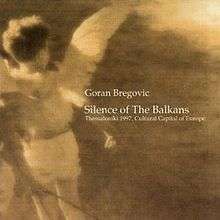Silence of the Balkans
| Silence of the Balkans | |
|---|---|
 | |
| Live album by Goran Bregović | |
| Released | 1998 |
| Recorded | December 30, 1997 |
| Label | Mercury |
Silence of the Balkans is Goran Bregović's live album recorded at his concert in Thessaloniki, Greece on December 30, 1997.
As part of the EU's ongoing initiative, Thessaloniki was designated European Capital of Culture for the year 1997, and Bregović's performance came as part of the city's final showcase.
Silence of the Balkans
It's called the 'Silence of the Balkans' but actually is the record of the sounds, the rhythm and the breath of the Balkans and Georgia,[1][2] but in different interpretation. A train leaves froms the old railway station of Munich and by passing all Balkan countries, stops in various cities and arrives in Thessaloniki. The last train stop, Thessaloniki, is also the last stop of the Cultural Capital of Europe, Thessaloniki 1997.
The performance has 2 levels. One that is live inside the stadium, and one film recorded in each train stop by Boris Milicović. At the performance of the last song, 3 children (one from Serbia, one Muslim and one from Croatian) from an orphanage in Sarajevo, call for peace.
Live performances from: the Municipal Orchestra of Thessaloniki (47 people), the Choir of Thessaloniki (50 people), 4 Bulgarian singers that work with Bregović in all lives performances, the Bulgarian dance ensemble 'Filip Kutev), 45 dancers from Greece, a polyphonic group from Albania, the former Yugoslavia singer Zdravko Čolić, the group of Aristidis Moshos,
Track listing
- Silence 1
- Delicious Solitude
- Train
- Silence 2
- Wedding
- Ederlezi
- Silence 3
- Chupchik
- Babylon
- Green Thought
- Silence 4
- Mocking Song
Notes
The second track in this album uses fragments of Andrew Marvell's poem "The Garden".
The end of the third track features the traditional Georgian songs, Tsin Tskaro and Sisa Tura.
References
- ↑ "Third track 'Train' from the album for comparison with Tsinstkaro".
- ↑ "Ensemble 'Rustavi' performing Tsinstkaro".